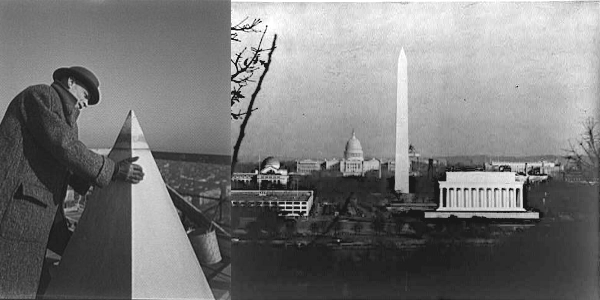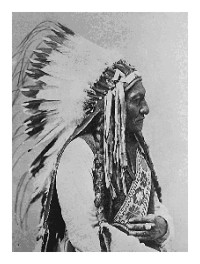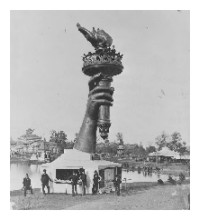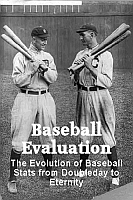Sponsor this page. Your banner or text ad can fill the space above.
Click here to Sponsor the page and how to reserve your ad.
-
Timeline
1884 - Detail
December 6, 1884 - The capstone of three thousand three hundred pounds is positioned atop the Washington Monument by the Corps of Engineers. The monument, five hundred and fifty-five feet tall and now completed after nearly thirty-seven years of work, would be dedicated in February of 1885.

When the pinnacle of the Washington Monument was placed atop its statuesque obelisk, it had taken thirty-seven years to go from inception to completion. Dedication would not occur until February 1885, but the work, for the most part, was done. There would be minor additional construction through the dedication and beyond until visitors were allowed to enter, which did not occur until October 9, 1888.
There were two stages of construction of the design, an Egyptian obelisk, by Robert Mills. The first, private, lasted from 1848 until 1854 before a lull in construction occurred due to funding. When the public phase started again in 1876-1884, it was finally completed by the U.S. Army Corps of Engineers. It was the tallest building in the world when completed, surpassing the Cologne Cathedral, five hundred fifty-five feet, five and one eighth inches.
The location chosen had been set aside in the geometric design of the city by Pierre L'Enfant, to be placed at the intersection of the lines south of the White House and lines west of the Capitol. The Washington Monument Society had commissioned the work by Robert Mills in 1845; they, a private organization, had been soliciting funds and designs since 1833. Mills' original design also included thirty one hundred foot columns ringing the obelisk. Those were not built.
On July 4, 1848, twenty thousand people, including dignataries ranging from President James K. Polk to future Presidents James Buchanan, Abraham Lincoln, and Andrew Johnson, watched as the cornerstone was laid. The foundation, an eighty foot step pyramid was started first, with the marble structure above it, fifty-five feet square at its base. A derrick pulled the stones upward. It took until 1854 before the Washington Monument had reached a height of one hundred and fifty-six feet.

Buy Chronology

Construction Halts
The year before construction halted, the Washington Monument Society began to have trouble. Members of the Know-Nothing Party took control of the board and administration. This frustrated donors, who refused to continue funding, and the private organization went bankrupt in 1854.
It stood for two decades idle in construction, not honoring the first President George Washington, but serving as an embarrassment. Various efforts were made in Congress, but the sectional crises over slavery and the eventual Civil War took their attention away from the monument to honor the founding father.
The Public Phrase, 1876 to 1884
Once the Civil War was over and the business of building the nation back together through Amendments to right wrongs and the Reconstruction efforts, though inefficient and sometimes wrong, on their way. With President Grant at the helm of government, the U.S. Congress passed a joint resolution to fund and complete the Washington Monument on July 5, 1876, during the middle of the nation's successful Philadelphia Centennial Exhibition, to honor its first one hundred years. Lt. Colonel Thomas Lincoln Casey of the Corps of Engineers was put in charge.
His first task was to strengthen the foundation, which he did not think strong enough to hold the growing structure. It took four years until he was satisfied with moving skyward. Problem was, the initial quarry used under the private phase was out of business; for some time they used stone from a quarry in Massachusetts which did not match the first, then finally switched to another in Baltimore. You can see the three different time periods of stone when you witness the structure today.
Casey reduced the height of the structure to ten times its width, thus five hundred and fifty-five feet instead of six hundred feet, and got rid of some of its original adornments, including the thirty columns that would have ringed the monument. He reduced the thickness of the walls by four feet.
Finally, on December 6, 1884, Lt. Colonel Thomas Lincoln Casey brought the capstone out of the window, all three thousand three hundred pounds of it, and gently placed it atop, including an aluminum tip. Standing on the grounds below, the crowd cheered.
The crowd would have to wait until its formal dedication, February 21, 1885, and even longer for the right to enter as finishing work on the internal ironwork, the knoll, and installation of memorial stones had to be completed. The monument was officially opened to the public on October 9, 1888. But the monument to honor its first President George Washington was complete, no longer an embarrassment, but a beacon to the rights of democracy and decency, not perfection, that the man from Mount Vernon had begun to instill in the new nation.
Image above: Montage: (left) Man atop monument at capstone, 1920/1950 (date within span), Theodore Horydczak. Courtesy Library of Congress; (right) Scene of the Washington Monument, 1923, Theodore Horydczak. Courtesy Library of Congress. Below: Photo of the Washington Monument taken from the World War II Memorial, 2008, americasbesthistory.com. Info Source: nps.gov; Wikipedia Commons.







